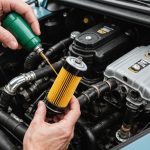Understanding Minibus Weight Distribution
Ensuring optimal weight distribution in a minibus is crucial for stability during travel. Properly balanced weight distribution contributes significantly to minibus handling by enhancing control and minimizing the risk of accidents. Passenger safety is also directly connected to how weight is managed, as an imbalance can lead to dangerous situations, such as swerving or tipping, particularly during sharp turns or sudden stops.
When weight in a minibus is not distributed evenly, it can negatively impact driving performance. For example, excessive weight at the rear may lead to oversteering, while a front-heavy load can cause understeering. Both scenarios make it challenging to maintain control, particularly for less experienced drivers.
Also read : Ultimate diy guide: safely replace your suv”s serpentine belt in easy steps
To prevent these issues, various techniques should be employed when loading passengers and cargo. It’s important to distribute weight evenly across the vehicle, considering both side-to-side and front-to-rear positioning. Cargo should be secured, and passengers encouraged to sit in a way that maintains balance, optimizing the driving experience. Overall, understanding and managing weight distribution in a minibus ensures a safer journey for everyone on board.
Safe Braking Techniques for Loaded Minibuses
Understanding how braking techniques must adapt to increased weight is essential for maintaining vehicle control. When a minibus is loaded, the stopping distance increases significantly, which affects how you should approach braking. Always allow extra space between you and the vehicle in front to accommodate for longer stopping distances, especially under wet or icy conditions where stopping can take even longer.
To enhance braking efficiency, gradually apply the brakes to prevent skidding and maintain control. This approach is crucial for driving safety and should be practised regularly. Additionally, consider using engine braking to slow down the vehicle more smoothly. By shifting to a lower gear, the engine can help manage speed without over-relying on the service brakes, which is particularly useful on declines or when approaching sharp turns.
Remain vigilant about road conditions and adjust your braking techniques accordingly. Always be ready to respond to sudden changes in traffic to ensure passenger safety. Control and caution are key factors in safely operating a minibus, especially under varying load conditions and challenging road environments.
Navigating Different Road Conditions
Driving a minibus requires adapting to ever-changing road conditions to ensure safety and comfort. From wet to icy or uneven surfaces, each requires specific driving strategies. On wet roads, reduce speed to maintain traction and keep a safe distance to prevent hydroplaning. In icy conditions, increase following distance and brake gently to avoid skidding. Utilising braking techniques such as gentle steering and gradual braking aids in maintaining vehicle control.
When handling turns and corners with a full load, slow down before entering the turn and accelerate gently once halfway through to keep minibus handling predictable. Each road condition demands unique driving strategies to optimise passenger safety.
Tackling steep inclines or declines requires further adaptation. When ascending, maintain a steady speed and downshift to manage power. On declines, use a combination of engine braking and gentle service brakes to control speed without overheating. Constant vigilance and adjusting techniques to match road conditions are key to securing a safe journey for everyone aboard. Understanding these strategies not only enhances driving performance but also ensures a safe and comfortable ride under any circumstance.
Legal Requirements for Driving a Minibus
Driving a minibus entails adhering to specific legal requirements, which vary by region but are critical for ensuring safety and compliance. A fundamental requirement is obtaining the appropriate licenses and certifications. Most regions necessitate a commercial driver’s license (CDL) with a passenger endorsement to operate a minibus professionally. This ensures the driver is trained and aware of unique challenges such as maneuverability and passenger management associated with larger vehicles.
Beyond licensing, it’s vital to understand the vehicle regulations pertaining to minibuses. These regulations often stipulate weight limits that dictate the maximum number of passengers and cargo a vehicle can carry safely. Compliance with these weight limits is crucial for maintaining vehicle control and stability. Moreover, weight limits help enforce balance, positively impacting minibus handling and passenger safety.
Local traffic laws also play a significant role in the operation of minibuses. Minibus operators must familiarize themselves with rules concerning speed limits, parking, and permissible routes, as these laws can affect both legal compliance and overall safety. Following these guidelines not only protects the driver and passengers but also contributes to safer roads for all users.
Essential Minibus Maintenance Checks
Regular vehicle maintenance is crucial for ensuring the operational readiness and safety of a minibus. Before embarking on any journey, focus on key maintenance tasks. Start by checking the tyre pressure and tread depth—essential factors for maintaining grip and ensuring safe travel conditions. Properly inflated tyres can significantly enhance vehicle control and reduce stopping distances.
Regular safety inspections are equally imperative. Conduct them to ensure components like brakes and lights function accurately. If you hear unusual noises during operation, investigate promptly as these can signal potential issues. Loose or worn brake pads and inconsistencies in the braking system can compromise passenger safety.
Keeping an eye on fluid levels like oil, brake fluid, and coolant is another critical aspect. Neglecting these can lead to engine overheating or brake failure. Look out for signs of wear, such as leaking fluids or unusual engine noises, which may indicate imminent mechanical failure.
Ultimately, a thorough regimen of pre-trip and post-trip inspections can help detect early issues, allowing for timely repairs and averted accidents. Safety checks are not optional; they are essential for the minibus’s operational readiness.
Quick Reference Checklists for Safe Driving
Preparation is key to safe driving in a minibus, and having comprehensive pre-trip and emergency checklists can enhance both passenger safety and operational readiness.
Essential Pre-Trip Checklist
Before any journey, ensure you conduct thorough pre-trip inspections to confirm the mechanical fitness of the vehicle. Include routine checks such as:
- Tyre Condition: Check for proper inflation and wear.
- Brake Functionality: Ensure all lights and brakes are working efficiently.
- Fluid Levels: Verify adequate levels of oil, coolant, and brake fluid.
Safety and Emergency Preparedness
In addition to mechanical checks, emergency preparedness is vital:
- Ensure a well-stocked first aid kit is on board.
- Regularly reassess emergency protocols and gear, including fire extinguishers and warning triangles.
Passenger safety should be prioritized. Implement procedures for ensuring all seatbelts function and passengers are briefed on emergency exits. Conduct regular drills to keep passengers informed. By following these checklists, ensure both driver and passengers are prepared for any situation, while enhancing comfort and security throughout the journey.











